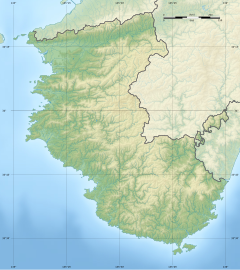Chōhō-ji (Kainan)
| Keitokuzan Chōhō-ji | |
|---|---|
慶徳山長保寺 | |
 Main hall | |
| Religion | |
| Affiliation | Tendai |
| Deity | Shaka Nyorai |
| Status | functional |
| Location | |
| Location | 689, Shimotsu-cho-kami, Kainan, Wakayama 649-0164 |
| Country | Japan |
| Geographic coordinates | 34°06′33″N 135°09′56″E / 34.10917°N 135.16556°E |
| Architecture | |
| Founder | Shōkū (性空) |
| Date established | c.1000 |
| Website | |
| Official website | |
Keitokuzan Chōhō-ji (慶徳山長保寺) is a Buddhist temple in the city of Kainan, Wakayama Prefecture, Japan. It belongs to the Tendai school of Japanese Buddhism. Its main image is a statue of Shaka Nyorai. Its Hondō, Tahō-tō Pagoda and are Daimon National Treasures,[1] and its daimyō cemetery is a National Historic Site.[2]
History[edit]
The early history of Chōhō-ji is not well-documented. Per the temple's own account, it was founded by a disciple of Ennin in the year 1000 at the request of Emperor Ichijō. Originally, it was situated to the west of its current location, and was relocated the Kamakura period. The existing Main Hall, Tahōtō and Daimon were built from the end of the Kamakura period to the Nanboku-chō period. The temple declined during the Sengoku period, but was revived in the early Edo period under the sponsorship of Asano Yoshinaga, daimyō of Kishū Domain.[3]
In 1666, Tokugawa Yorinobu, who had replaced the Asano clan as daimyō, decided to make the temple the bodaiji for the Kishū Tokugawa clan, and in 1672 Tokugawa Mitsusada donated estates with a kokudaka of 500 koku for the temple's upkeep. On the eastern slopes of the mountain behind the precincts, a large cemetery was created for the Kishū Tokugawa clan, with the exceptions of the tombs of the 5th daimyō (Tokugawa Yoshimune) and 13th daimyō (Tokugawa Iemochi), who (as shogun), had their tombs at Kan'ei-ji in Edo. There are 28 tombs in the cemetery, twelve of which are for various daimyō, and the remainder are for their wives and children. Each tomb is surrounded by a stone fence, with a granite-paved floor and basalt approach and walls. The shape of the tombstone itself varies depending on the generation. There are also a total of 330 stone tōrō lanterns.[3]
The temple is about nine minutes by car from Shimotsu Station on the JR West Kisei Main Line.[3]
Cultural properties[edit]
- Main Hall - National Treasure.[4] Rebuilt in 1311.
- Tahōtō - National Treasure.[5] Rebuilt in 1357.
- Daimon - National Treasure.[6] Rebuilt in 1388.
- Chinju-dō - Important Cultural Property.[7] It was rebuilt in Kamakura period.
Gallery[edit]
-
Pagoda
-
Tokugawa Mitsusada's grave
-
Tokugawa Yorinobu's grave
See also[edit]
References[edit]
- ^ Shiga Prefecture List of Cultural Properties (in Japanese)
- ^ "和歌山藩主徳川家墓所" (in Japanese). Agency for Cultural Affairs. Retrieved 20 August 2020.
- ^ a b c Isomura, Yukio; Sakai, Hideya (2012). (国指定史跡事典) National Historic Site Encyclopedia. 学生社. ISBN 978-4311750403.(in Japanese)
- ^ "長保寺本堂" (in Japanese). Agency for Cultural Affairs. Retrieved 20 August 2020.
- ^ "長保寺多宝塔" (in Japanese). Agency for Cultural Affairs. Retrieved 20 August 2020.
- ^ "長保寺大門" (in Japanese). Agency for Cultural Affairs. Retrieved 20 August 2020.
- ^ "長保寺鎮守堂" (in Japanese). Agency for Cultural Affairs. Retrieved 20 August 2020.





